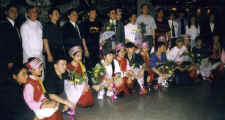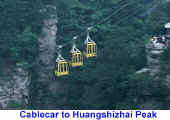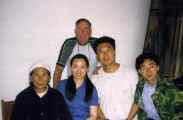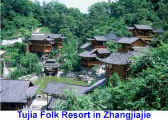|
Journal
Contact Us
Poems
Site Map
Search
| |
Off the beaten track, China is trying
to open this area up to tourism - it is difficult for Westerners, but beautiful!
Arrival - We arrived at our hotel in the
middle of the night after a bumpy flight from Chengdu and a bumpier ride from
the middle of town. Our van driver received a couple of cell-phone calls
while in transit and tried to divert (kidnap?) us to a different hotel, but after a bit of
an argument, and a firm B� B� (No No!) from Judi he took us on to the Pipa Xi
Hotel.  Only
Mr. Tang Ming spoke English, all signs were in Chinese characters only, and trying to order from
the all-Chinese menu was a a real challenge (we just pointed and hoped that
what we got was edible), but we muddled through. The one surprise of the visit came the next night - the top Chinese
Gymnastics Team came to Zhangjiajie for a visit and stayed at our hotel.
They grabbed all of the management, as well as we 2 Westerners, and took the
photos - hope the subversive monitors are not watching. Mr. Tang Ming was
a great help and knowledgeable tour guide, click
for his details. Only
Mr. Tang Ming spoke English, all signs were in Chinese characters only, and trying to order from
the all-Chinese menu was a a real challenge (we just pointed and hoped that
what we got was edible), but we muddled through. The one surprise of the visit came the next night - the top Chinese
Gymnastics Team came to Zhangjiajie for a visit and stayed at our hotel.
They grabbed all of the management, as well as we 2 Westerners, and took the
photos - hope the subversive monitors are not watching. Mr. Tang Ming was
a great help and knowledgeable tour guide, click
for his details.
Beautiful scenery - This was a  wonderful
scenic area that appeared to be set aside for Chinese tourists. wonderful
scenic area that appeared to be set aside for Chinese tourists.  But the scenery made
up for all of the ordeals: tall peaks remain as the rest of a large plateau had eroded 1000'
from its original height. Natural bridges have survived the onslaught of time
and steep cliffs overhang the trails.
But the scenery made
up for all of the ordeals: tall peaks remain as the rest of a large plateau had eroded 1000'
from its original height. Natural bridges have survived the onslaught of time
and steep cliffs overhang the trails.
Rare Westerners - On the first
day a cable-car took us, and hundreds of others, to the top of one of the peaks - where we
were the only Western faces to be seen.  The next day, we hiked 1000' up a
nearby ridge, and met Sun
Xiao-Feng and her husband, visitors from Northern
China. We had a wonderful time communicating with them with a little English, a little Chinese, and lots of pointing, laughing,
and pictures. Again, we were the only Westerners around.
The next day, we hiked 1000' up a
nearby ridge, and met Sun
Xiao-Feng and her husband, visitors from Northern
China. We had a wonderful time communicating with them with a little English, a little Chinese, and lots of pointing, laughing,
and pictures. Again, we were the only Westerners around.
Bao Feng - A picture on a brochure we had
picked up in Singapore captivated us - a small boat on a clear lake amid steep hills. We chased that
dream and found it at Bao Feng, a small lake in the mountains near Zhangjiajie,
where peaks rose 500' from the water's edge as we tooled around in a quiet
little boat. Unfortunately, we had to rush through this cruise on our way to an early rendezvous
at the train station.
Tujia Folk Custom Village - Mr. Tang  had
provided us with information and advice during our stay, and recommended that we
visit the 'museum' in Zhangjiajie City. This turned out to be a theme
village, dedicated to the Tujia, a minority in group in China trying to preserve
their culture. The buildings were all wood, no metal fasteners of any
kinds and served as rooms for the attached hotel. The museum had a few
interesting pieces of carved wood (they take roots and shape them into animals
or other interesting figures) and few geological items (i.e. 'rocks').
During a performance of the 'Crying Bride' legend, they asked for volunteers
from the audience for some parts, but avoided us - probably felt we wouldn't
understand the instructions. had
provided us with information and advice during our stay, and recommended that we
visit the 'museum' in Zhangjiajie City. This turned out to be a theme
village, dedicated to the Tujia, a minority in group in China trying to preserve
their culture. The buildings were all wood, no metal fasteners of any
kinds and served as rooms for the attached hotel. The museum had a few
interesting pieces of carved wood (they take roots and shape them into animals
or other interesting figures) and few geological items (i.e. 'rocks').
During a performance of the 'Crying Bride' legend, they asked for volunteers
from the audience for some parts, but avoided us - probably felt we wouldn't
understand the instructions.
Note:
The �crying bride� legend comes from the dynasty period where a landlord had
the habit of raping brides. He knew they were brides because they laughed and
were happy. So the peasants collaborated, and decided that all brides should
cry, pretending they were going to a funeral rather than a wedding. The pretense
came unraveled once the landlord figured it out, but they fooled him by setting
him up with a real cadaver for one of his sessions, so he dropped the rape habit
and the custom stuck, even today the Tujia brides cry for the period around
their wedding. Next
stop, Guilin on a train-bus combo. |